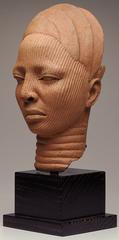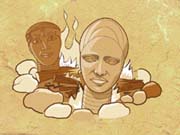

The shrine head is made of terra-cotta ("baked earth"), a naturally
occurring clay. Although porous, when fired it increases in strength and
can hold liquids without returning to its PLASTIC
state.
 Terra-cotta
is composed of earth containing organic and mineral substances that give
it a reddish brown color. IRON
OXIDE produces this distinctive color when the clay is fired. The
color is also affected by other minerals present and by the firing temperature.
Ife pieces were most likely fired in an open wood fire. It required great
skill to control the temperature and make the firing even, to prevent
dark patches from forming on the object. The final color ranged from dark
brown to orange, buff, tan, or pink. Ife shrine heads were most likely
painted as well; traces of pigment can sometimes be found on parts of
the face and neck.
Terra-cotta
is composed of earth containing organic and mineral substances that give
it a reddish brown color. IRON
OXIDE produces this distinctive color when the clay is fired. The
color is also affected by other minerals present and by the firing temperature.
Ife pieces were most likely fired in an open wood fire. It required great
skill to control the temperature and make the firing even, to prevent
dark patches from forming on the object. The final color ranged from dark
brown to orange, buff, tan, or pink. Ife shrine heads were most likely
painted as well; traces of pigment can sometimes be found on parts of
the face and neck.
The use of fired clay for making vessels probably began in Africa, where terra-cotta pottery has been found dating from the eighth millennium B.C. The earliest sculptural terra-cottas, mostly hollow-built heads, were excavated in northern Nigeria and date from around 500 B.C.

Key ideas.
Where does it come from?
What does it look like?
How was it used?
How was it made?
How big is it?
Who Knows?
Additional resources.
